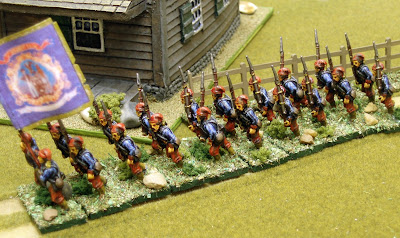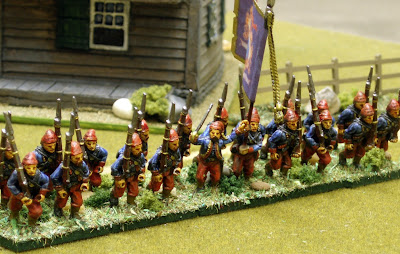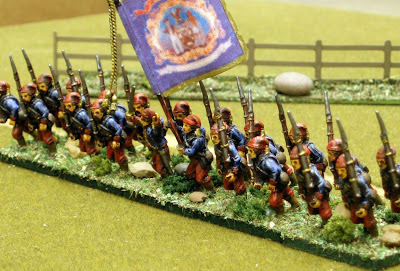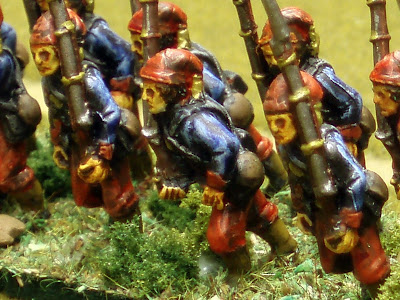As promised some time ago, just a short post to describe the somewhat shambolical game that DG and I managed to get in while he was down for the Warfare show weekend..
We played using Blitzkrieg Commander ver 2, and the scenario had two forces of about 1000 points each meeting up at a village in a gorge between two dominating ridge lines.
German orbat was as follows:
British orbat was as follows:
..in addition the British also had ten artillery stonks at their disposal - five of smoke, and five of HE.
We diced before the game and the British (me) ended up as defenders, tasked with blocking the gorge to the German advance.
I deployed with my tanks hidden (behind the ridge) but my infantry dug in along the ridge lines either side of the village, with the 25pds and the CO in the village - the following shows my left flank with DG's forces advancing on them..
We played using Blitzkrieg Commander ver 2, and the scenario had two forces of about 1000 points each meeting up at a village in a gorge between two dominating ridge lines.
German orbat was as follows:
| 1 | CO (CV10) | Command |
| 1 | HQ (CV9) | Command |
| 3 | Infantry Unit | Infantry |
| 1 | Support Unit (MG) | Infantry |
| 1 | Support Unit (Mortar) | Infantry |
| 1 | HQ (CV9) | Command |
| 3 | Infantry Unit | Infantry |
| 1 | Support Unit (MG) | Infantry |
| 1 | Support Unit (ATG, 37mm) | Infantry |
| 1 | HQ (CV9) | Command |
| 3 | Light Panzer Unit (Pz-II) | Armour |
| 1 | HQ (CV9) | Command |
| 2 | Light Panzer Unit (Pz-III 37mm) | Armour |
| 1 | Dive Bombers (Stuka) | Aircraft |
| 10 | Transport Unit (Trucks/Half-Tracks) | Transport |
British orbat was as follows:
| 1 | CO (CV9) | Command |
| 1 | HQ (CV8) | Command |
| 3 | Infantry Unit | Infantry |
| 1 | Support Unit (MG) | Infantry |
| 1 | Support Unit (ATG, 2pdr) | Infantry |
| 1 | HQ (CV8) | Command |
| 3 | Infantry Unit | Infantry |
| 1 | Support Unit (MG) | Infantry |
| 1 | Support Unit (Mortar) | Infantry |
| 1 | HQ (CV8) | Command |
| 3 | Light Tank Unit (Vickers Mk-VI) | Armour |
| 1 | HQ (CV8) | Command |
| 3 | Cruiser Tank Unit (A13) Armour | Armour |
| 1 | Artillery Unit (25pdr) | Artillery |
| 8 | Transport Unit (Trucks) | Transport |
| 3 | Transport Unit (Universal Carriers) | Transport |
..in addition the British also had ten artillery stonks at their disposal - five of smoke, and five of HE.
We diced before the game and the British (me) ended up as defenders, tasked with blocking the gorge to the German advance.
I deployed with my tanks hidden (behind the ridge) but my infantry dug in along the ridge lines either side of the village, with the 25pds and the CO in the village - the following shows my left flank with DG's forces advancing on them..
DG largely mirrored this set up himself, with his Pz II's on the left and the III's on the right...
...and so the shambles started! 😏
I think it safe to say that the first failure was that DG's Paznzer II's never did get to the battle line - German HQ's have better ratings than the British (command roll under 8 is all that's required on 2D6!) but again and again, DG kept throwing over - that's going some!
In move two or three I threw boxcars while dicing for my firing on the the right flank - command blunder in Blitzkrieg commander terms! Checking the ensuing result ended with my safely entrenched infantry throwing themselves down the hill at the advancing Germans! See following for before..
..and after!
Next, DG diced for the arrival of his Stuka - all that infantry was far too tempting a target... 😁 He then proceeded to roll the deviation dice to see where the bombs landed only to find out that his guys were so close to mine that they got bombed as well!
Shortly after this my 25pdr started to brew up his Pz III's, and the infantry on my left flank started throwing in all the metal at their command, and before we knew it, the Germans were at breakpoint and the British (amazingly) had won!
Post Match Analysis:
Shortly after this my 25pdr started to brew up his Pz III's, and the infantry on my left flank started throwing in all the metal at their command, and before we knew it, the Germans were at breakpoint and the British (amazingly) had won!
Post Match Analysis:
- A fun game despite the shambolical way that it played out... we blame it mostly on the lack of practice, like most rule sets Blitzkrieg Commander deserves close attention and DG and I hadn't played since April
- Artillery and air support are powerful - everything within a 20cm square template is hit
- We toyed with the idea of allowing casualty points and suppression to be carried over between moves - the game would be more bloody as a result
- Something about targeting doesn't seem quite right - when we diced for hits from multiple firing stands we tended to pick one base and concentrate all the fire on it in order to destroy it quickly. Would all stands in a unit fire at the same target?? We talked about ways of dividing the shots randomly amongst all bases in the opposing unit - we might be better perhaps to use target priority rules, or fire at closes first, etc. More thought required
- Refreshments on this occasion was a lovely glass of Badger "Tanglefoot" along with curry spiced nibbles - it seemed right given the desert theatre!





 ), Newline are £1.75 for four... that's a difference of 69p & 44p per figure roughly - an astonishing difference!
), Newline are £1.75 for four... that's a difference of 69p & 44p per figure roughly - an astonishing difference!
















